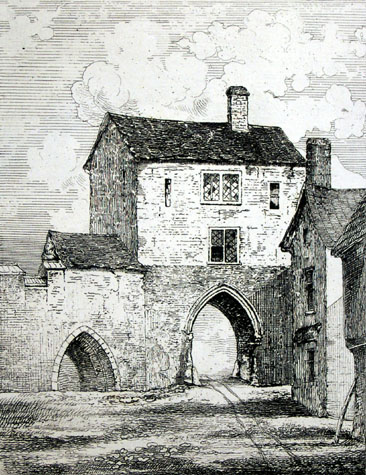
|
Introduction
Heigham Gate was at the north-west corner of
the city and was built on the low ground close to the Wensum on the west
bank of the river. The land here is about 3 metres above the Ordnance
Survey datum for sea level. The gate was known variously in the
Middle Ages as Hell Gate ('Portae Inferni'), possibly because of this
position low and close to the river [Blomefield, page
112], and as Blake, or Black Gate. Heigham Street, known also
as Nether Westwyck, leading out to the gate was very narrow and had tall
houses on either side and the area, close to the wet marshy river, must
always have been damp and often foggy. The gateway was narrow being a
postern capable only of admitting small carts. [Fitch,
page 21]
To the east of the gateway, a short length of
wall (probably less than 40 metres) ran down to a circular tower on the
bank of the river. The tower was just up stream from a water mill
known from the 16th century as the New Mill. Until the river was
channelled for this mill, this area was presumably very wet and marshy and
provided a natural defence in the Middle Ages. The flint-built
defensive wall started again at the tower at Oak Wall Lane over 400 metres
up stream to the north.
On St Matthews Day in 1221 (5 Henry III) a
common way leading from 'Blake Gate' to the river was inspected and a
yearly rental for its use was agreed. [cited in SMR
NF26127] These lanes inside the walls giving access to the river are
obviously very important and are found at River Lane and at King Street
running down to the west Boom Tower.
The gate was rebuilt or remodelled in the
14th century under the auspices of one Richard Spynk, citizen of Norwich. [Extract
from The Old Free Book, Hudson & Tingey, vol. II, pages 216-22]
In 1842 Blyth stated that the gate 'fell down in the beginning of the last
century' [Blyth, page 4], although it is
likely that he means at the end of the eighteenth century, given that
orders to pull down and repair the gate were given in 1742. [Tonnage
Books, N.R.O. NCR Case 19 Shelf C; cited by Fitch page 22] It is
not certain, however, that these instructions were fully carried out.
Blyth also reports that 'the city wall remains from the site of this gate
to the small stream called the Old River, where it was terminated by a
tower, now in ruins, as is also the wall, the whole of it being in a state
of decay' [Blyth, page 4].
|
